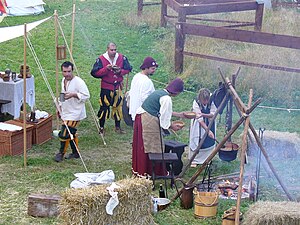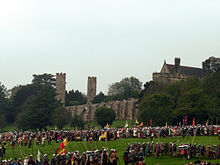Medieval reenactment
Renaissance Fair participants generally borrow from a range of history and often incorporate fantasy or Hollywood-inspired elements into a presentation for public entertainment.
In contrast, activities of the Society for Creative Anachronism (SCA) include everything from artistic disguises for modern items such as ice chests, to exhaustive research and authentic living history events.
New Households wishing to enter the Federation are sponsored by established ones, and endure a probationary period to ensure standards are observed.
In modern times, medieval reenactment has been popular in the United Kingdom, starting in the late 1960s and growing every year since, with groups from all over England, Scotland, Ireland and Wales participating in events.
UK reenactors can be seen throughout the country during the summer months at battles, fairs, carnivals, fetes, pubs and schools.
[1] The open air museum Middelaldercentret uses living history and historical reenactment to portrait a part of a small Danish merchant town.
In general, the specific German approach of Authenticity (reenactment) is less about replaying a certain event, but to allow an immersion in a certain era.
Historic city festivals and events are quite important to build up local communities and contribute to the self-image of municipalities.
[citation needed] In Poland, the Battle of Grunwald reenactment every year on 15 July is the best known and attracts participants and visitors from many other countries.
[1] In Szeklerland, Transylvania are many Hun, szekler knight, early Hungarian and hussar reenactment groups and camps.
In Portugal there is one of the biggest historical recreations in Europe that takes place every summer called Viagem Medieval em Terra de Santa Maria.







Medieval living history in Russia . Historical Reconstruction Club from Ruzsky Urban District , Moscow Oblast .